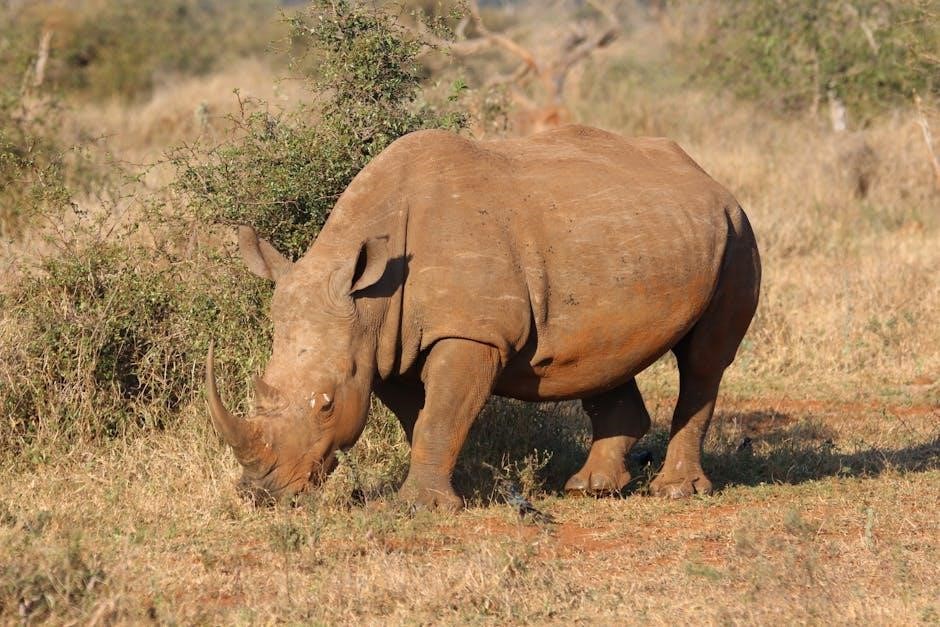The black rhino guide provides information on these animals, with
historical data
and current status, using internet sources for accuracy always helping readers understand them better every day online.
Historical Background of Black Rhino Population
The black rhino population has undergone significant changes over the years, with historical data showing a substantial decline in numbers. According to internet sources, the population decreased from around 70,000 individuals in 1970 to just 2,410 in 1995, a decline of over 96% in just 20 years. This drastic reduction was largely due to large-scale poaching, which had a devastating impact on the species. The historical background of the black rhino population is complex and multifaceted, involving a range of factors and events that have contributed to the current state of the species. Understanding this history is essential for developing effective conservation strategies and ensuring the long-term survival of the black rhino. By examining the historical data and trends, conservationists can identify key areas for intervention and work to protect and preserve the remaining populations. Overall, the historical background of the black rhino population is a critical component of any conservation effort.
Current Conservation Status
The current conservation status of the black rhino is a major concern, with the species listed as Critically Endangered on the IUCN Red List. According to recent data, the in-situ population of black rhinos is approximately 6,421 individuals. This number is a result of persistent conservation efforts across various regions, which have helped to stabilize and slowly increase the population. The conservation status is constantly being monitored and updated by conservation organizations and wildlife experts. The IUCN Red List classification is based on a thorough assessment of the species’ population trend, geographic range, and other factors. The classification as Critically Endangered indicates that the black rhino is at high risk of extinction in the wild, and urgent conservation actions are necessary to protect the species. Conservation efforts are ongoing to protect the black rhino and its habitat, and to address the major threats facing the species. Overall, the current conservation status of the black rhino is a pressing issue that requires continued attention and action;

Physical Characteristics of Black Rhinos
Black rhinos have distinct physical features, including size and weight, with internet sources providing detailed information always helping readers understand them better every day online naturally.
Size and Weight of Black Rhinos
The size and weight of black rhinos are notable characteristics, with males being larger than females, according to internet sources.
Their height at the shoulder is approximately 4.5 to 6 feet, with a head-to-tail length of around 14 feet.
The weight of these animals is also significant, ranging from 1,760 to 3,080 pounds.
This size and weight range is an important aspect of their physical characteristics, and internet sources provide detailed information on this topic.
Understanding the size and weight of black rhinos is essential for their care and conservation.
Internet sources offer a wealth of information on this subject, including data on their physical characteristics and how they relate to their habitat and behavior.
The size and weight of black rhinos are just one aspect of their overall physical characteristics, but it is an important one for understanding these animals.
By studying the size and weight of black rhinos, researchers and conservationists can better understand their needs and work to protect them.
This information is vital for the conservation of black rhinos and can be found in various internet sources.
Overall, the size and weight of black rhinos are fascinating characteristics that are essential to their survival and conservation.
Skin Color and Texture of Black Rhinos
The skin of black rhinos is a notable feature, with a gray-colored and thick layered texture, according to internet sources.
This skin color and texture serve as a form of protection for the animal, and are also an important aspect of their physical characteristics.
The gray color of their skin helps them to blend in with their surroundings, while the thick layers provide protection from the elements and potential threats.
Internet sources provide detailed information on the skin color and texture of black rhinos, including its composition and function.
The skin of black rhinos is also relatively rough, which helps to provide additional protection and support.
This unique skin color and texture are essential to the survival and well-being of black rhinos, and are an important area of study for researchers and conservationists.
By understanding the skin color and texture of black rhinos, we can gain a deeper appreciation for these amazing animals and work to protect them.
The skin color and texture of black rhinos are just one aspect of their fascinating physical characteristics, and internet sources offer a wealth of information on this topic.
Overall, the skin of black rhinos is a remarkable feature that plays a critical role in their survival and conservation;

Threats to Black Rhino Populations
Major threats include human activities and natural factors affecting populations using
- internet
sources for information always.

Poaching and Its Impact on Black Rhino Populations
Poaching is a significant threat to black rhino populations, with large-scale poaching having depleted numbers in the past. According to internet sources, the demand for rhino horn in traditional medicine and as a status symbol drives poaching. The impact of poaching on black rhino populations is devastating, with numbers declining drastically over the years. Internet sources provide information on the historical decline of black rhino populations due to poaching, with numbers decreasing from around 70,000 individuals in 1970 to just 2,410 in 1995. The persistent conservation efforts across the internet and in various locations have helped to increase numbers, but poaching remains a major threat. Efforts to combat poaching and protect black rhino populations are ongoing, with the use of internet sources to raise awareness and provide information on the issue. The impact of poaching on black rhino populations is a complex issue, with many factors contributing to the decline of these animals.
Habitat Loss and Fragmentation
Habitat loss and fragmentation are significant threats to black rhino populations, with the destruction of natural habitats due to human activities such as agriculture and urban development. Internet sources indicate that forest destruction for palm oil and paper pulp is a major contributor to habitat loss. The fragmentation of habitats leads to small, isolated populations that are unable to breed, further threatening the survival of black rhinos. The loss of habitat also reduces the availability of food and water, making it difficult for black rhinos to survive. According to internet sources, habitat loss is a major factor in the decline of black rhino populations, and conservation efforts are necessary to protect and preserve their habitats. The preservation of natural habitats is essential for the survival of black rhinos, and internet sources provide information on the importance of habitat conservation. Habitat loss and fragmentation are complex issues that require urgent attention and action to protect black rhino populations.

Conservation Efforts for Black Rhinos
Conservation efforts are ongoing to protect black rhinos, with organizations working together to implement effective strategies always using internet sources for information and guidance online daily.
Protected Land and Conservation Areas
Protected land and conservation areas play a crucial role in the preservation of black rhinos, providing a safe habitat for these animals to thrive. The establishment of national parks and wildlife reserves has helped to protect black rhinos from poaching and habitat loss. These protected areas are typically managed by government agencies or conservation organizations, which work to ensure the long-term survival of black rhinos. The protection of land and conservation areas also helps to preserve the natural habitat of black rhinos, including grasslands, savannas, and forests. Additionally, protected areas provide opportunities for black rhinos to interact with other species, which is essential for maintaining a healthy ecosystem. Overall, protected land and conservation areas are essential for the conservation of black rhinos, and continued efforts are needed to protect and expand these areas. Conservation efforts are ongoing to protect black rhinos and their habitats.
Importance of Habitat Preservation for Black Rhino Survival
The preservation of natural habitats is crucial for the survival of black rhinos, as it provides them with the necessary resources to thrive. Habitat preservation helps to maintain the diversity of plant and animal species, which is essential for the long-term survival of black rhinos. The preservation of habitats also helps to protect black rhinos from human-wildlife conflict, which is a major threat to their survival. Furthermore, habitat preservation helps to maintain the ecological balance of the environment, which is essential for the health and well-being of black rhinos. The preservation of habitats is a complex process that requires the involvement of governments, conservation organizations, and local communities. By working together, it is possible to protect and preserve the natural habitats of black rhinos, and ensure their survival for generations to come. Habitat preservation is a critical component of black rhino conservation efforts, and it requires ongoing support and commitment.

